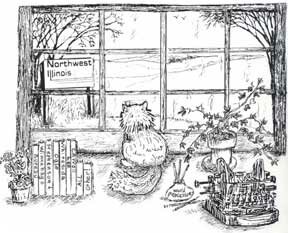Discover rewarding casino experiences. 
|
John Ankeny saw the prospects of the place in December of 1829 when he and two other men were laying out a road from Apple River (Elizabeth) to the Rock River, Ogee’s Ferry, later Dixon, Ankeny liked what he saw and decided to make a claim. He peeled the bark from a tree and wrote down the particulars on the smooth, exposed surface ... His name, date, extent of claim and his intention to settle his family there. The three moved on to the Rock River but returned in a few days to discover that Isaac Chambers and another man were cutting logs in the timber, readying to build a cabin at the site. No amount of talk could budge Chambers from the spot so, Chambers moved down the trail a little way and would build there (Sec. 17, Buffalo Twp.). Such action split the two early settlers, as you can imagine, there in the wilderness. The incident occurred Christmas day, 1829. All things were not holly bright and jingly bells cheery! Further aggravating the rift took place soon after when Ankeny, running out of supplies, took one of his sons, Oliver, with him to Galena to stock up, leaving another son, Harrison and a hired hand at the cabin. At that time a terrible blizzard struck, snowing the two in at the cabin. They ran out of provisions entirely and went the short distance down trail to Chambers’ place asking for help. Believing he, too, would run out of supplies Chambers denied them anything—strictly against the code of the frontier. When Ankeny and son arrived home and were told of the neighbors’ denial, the breach was further widened and might have continued if necessity hadn’t solved the argument. Each man had two yoke of oxen but different size plows ... Chambers had a large breaking plow that could cut through the heavy, thick prairie soil but not enough ox power to pull it. Ankeny with two yoke, had but a small plow that wouldn’t cut the virgin soil. Grunts and ahems were the short conversation that made one another aware of the solution. Ankeny’s oxen were put with Chambers bovine on his large, large plow and, ta-da, Ankeny drove the plow and Chambers guided the oxen. The first few days all was silence and strain but after awhile they being “men of broad intelligence and social and genial natures, the restraint imposed by previous difficulties were worked out and in after years a lasting relationship developed.” Every year or so after Col. Stevenson’s arrival with a stock of merchandise, a store or tradesman was added to the number of stores at what became Buffalo Grove until by 1852 there were six to provide the growing neighborhood with their needs. Its name became familiar throughout the Northwest not only for its commercial enterprise but because just on its northern limits there was a vast acreage of buffalo bones the residue of those great beasts that must have roamed widely here at one time but which in the winter of 1776-’77 were crowded in together by a blizzard and couldn’t move thus starving to death en masse. The late Russell Poole pointed out the site some years ago ... South of the railroad tracks, east of the lime kiln. With the trail well-worn by the 1830’s, the village was a destination and known in the Black Hawk War. Citizens of the place were warned twice to leave the remote spot lest the Indians attack. They obeyed but on May 19, 1832 William Durley, a lead miner, and two other volunteers set out from Galena with a dispatch for military headquarters then at Ft. Dixon on the Rock River. Unfortunately, Durley was ambushed by some Indians just northwest of Buffalo Grove while the other two escaped. A group of men on an errand to care for the livestock at the settlement discovered the body, just one victim of the unnecessary conflict. Seventy-eight years later an engraved boulder was set along side the present day road north of the site of Buffalo Grove, just off the Polo-Milledgeville blacktop beyond the sewer plant. Its easily found. Not at this spot was Durley buried because that was back in the timber, but out in the open where respects may be paid to just one of the many who sacrificed their lives for later generations in the building of our nation. It is fenced neatly and the grass mowed around it to further identify one period of our area’s history, now all of a hundred eighty years ago. The bones of Durley and the buffalo may be a morbid memorial but they are truly American. There were many Easterners coming in to settle, many additions and changes around Buffalo Grove including Oliver Kellogg who had set up a stage stop near Kent in 1827 to catch the comers and goers on the Peoria-Galena trail. It became a site of battle during the Black Hawk also. Before that however, Kellogg bought out Chambers’ claim at Buffalo Grove, his wife being a sister to John Dixon, who had taken up the ferry on the Rock River. She wanted to be closer to family. Isaac Chambers, meanwhile went over to near present day Brookville to set up another stage tavern stop to catch a branch of the busy trail north-westward. He first built a cabin, then a brick home that still stands. The stone bridge, half of which still stands, was built in later years. Abraham Lincoln did not walk over it during the Black Hawk War despite what others might say! It is thought he did camp there on his way to near Kent where a monument was erected in the nineteenth century to commemorate that battle. There’s lots of interesting stories all around us. Claim jumping, Indian campaigns, the unyielding wilderness to cope with, were all a part of everyday life to say nothing of the Banditti. Yes, Bandits who stole settler’s horses on a regular basis, made counterfeit money, murdered lonely travelers and generally kept the pioneers on edge for their ruthless activities. Nearly every neighborhood had a “family” either legitimate or “make-do” who was connected in some way to one another. They ranged from at least Ohio, across Indiana across northern Illinois into Iowa to Missouri and Kansas and farther West. The “Banditti of the Prairie,” as one book called them, weren’t in franchise but you might think they were in passing off stolen horses, robbing banks here and there, Making fake money was their creative outlet ... Anything a gang could do in the 1840’s and beyond, they’d try down in the Winnebago swamp, Lee County. Many a traveler disappeared because that “station” waylaid them. Lanark’s first lawyer moved to Kansas to hunt down the murderers of his brother. They were the notorious Bender gang. Locally, it was the Driscoll gang, Ogle County, who ranged far and wide but were killed themselves by a possé of over a hundred who shot them in unison to rid the area of their terrible influence. Yes, just another period that could have set back the progress of Buffalo Grove. During the fifties there was the anxiety of the Underground Railroad; the hiding of the African-American escaping from the South. Fulton was a likely entry point (it was the “Narrows of the Mississippi”), the route eastward and north to Wisconsin and/or the anonymity of Chicago. Or to Canada. There are known Underground stations through Whiteside into Carroll counties with Eagle Point just west of Buffalo Grove, an active participant in the abolitionist movement, “New Town,” Polo, had a ‘station’ and probably “Old Town” did, too. And while tough times, serious issues faced Buffalo Grove folks, the one thing that could have done them in was “St. Marion.” It was a town platted in 1835 by Oliver Kellogg and J.D. Stevenson. Its rectangular is shown on a hand drawn map in the 1976 Ogle County history. For some reason it never took off although neatly coursed. The post office however, never changed its name from Buffalo Grove. It’s what the native Old Towners could do! Buffalo Grove outshone Sanfordville and its sawmill (Burwick, where Wilson’s grist mill drew custom from all around. Nor did Eagle Point with the “Spencer Manufactory” and complimentary trades and its residents of some social status. All that competition and Buffalo Grove persevered until 1853 when the Illinois Central Railroad came straight up the state establishing depots along the way ... There were five in Ogle alone: Woosung, Polo, Haldane, Forreston and Baileyville. POLO was platted about a mile east of Buffalo Grove for a depot. A daring plot but successful even though the following paragraph, in part, was taken from an early twentieth century Ogle history. Next week we’ll explore Polo’s initiatory days. For now, we are intimidated by the following reference about Polo. “The early history of the town is difficult to determine. Like Topsy, it just growed. People here now saw it grow but paid little attention to it ... It was felt by some that Buffalo Grove was doomed (with the railroad’s arrival) though some in the village were determined to fight against it—to fight against Fate.” What was one thing the Buffalo Grove’s did to keep themselves at the forefront? Tune in. .
|






